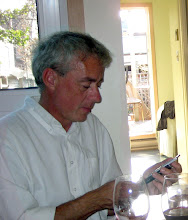Deer - Two Ways: Way One: Roasted: Ciervo
This is Oven Roasted Deer with Raspberry Sauce
(PDA camera {an iPaq by the way})
The deer is farm raised, sort of like cows are, but more open pasture style; it's sweet, tender and not "gamey" like one might anticipate if it was wild/forest hunted deer.
Using the raspberry sauce that I made the other day I quick roasted the thingy. This same procedure can be used on pretty much any thick chuck of tender meat.
Oven Roasted Deer with Raspberry Sauce
Time: 30 minutes total
Ingredients
- 400 gr ciervo [1# deer], in this case a sort of "loin"-like piece - long and roundish
- salt, kosher-type
- olive oil, to anti-stick the pans
- white wine, several splashes worth
- 125 ml raspberry sauce [4,5 oz]
Procedure
- It's best if you get the meat out of the fridge an hour or two before cooking so that it can reach room temperature - it roasts more easily, more evenly, this way. If you can't, or forget, as I often do, and the meat is very cold, set the oven 10-15 degrees lower to roast slower.
- Set oven to Hot, 195 C [380F]
- Clean up the deer meat, removing any silver-skin, sinewy strips from the outside of the meat; cut off the straggly parts so that it's got a nice consistent shape
- Don't throw away any of the residual meat from doing this, save it for making the sauce
- You can do this hours or a day in advance
- Salt the meat (no pepper today)
- Wait a minute before cooking to allow the salt to absorb into the meat - or wait a hour or two - no problem
- A little (very little) oil into a large, hot, frying pan and we sear the meat
- Not too too much oil; we're not deep frying this
- Deer meat is quite pink and does not "brown" the same as cow. We're out to develop a crust on the surface - which theoretically seals in the juices - and positively adds loads of flavour [flavor] due to some kind of caramelizing effect (the maillard reaction [in which, as we know, the reactive carbonyls of certain sugars interact with the nucleophilic amino groups of the products amino acids])
- Put the meat in the pan and don't move it. Let the heat do it's work. Avoid turning the meat around and around in the pan. Like the professionals - just leave it alone.
- Listen for a change in the sound of the frying after a minute - that's the moment when it's "seared"enough. Or, failing that, wait a minute and take a peek, lifting one end with a spatula
- Once seared, transfer to an oiled roasting pan and stick it in the preheated oven
- Add a generous splash of white wine to cover the bottom of the roasting pan very shallowly. Not too much because we aren't poaching the meat. Only enough to add humidity to the air in the oven and to keep the meat's juices from burning in the bottom of the pan
- Back to the frying pan -hot - sauté the little meat bits left over from cleaning up the meat
- Deglaze a little, if needed, to avoid burning the remains of the searing process
- Deglazing is the process of using a splash of white wine; make that two, to clean the pan
- Scape off the meat that's stuck to the bottom (there's a lot of flavour in there)
- Once cleaned up transfer this to a smaller frying/sauce pan. The one used for searing the meat is quite big and controlling the sauce-making process in a smaller pan is somewhat easier.
- Add the raspberry sauce to this pan
- Reduce - bubbling away slowly while the deer is in the oven roasting
- You'll see "steam" rising from the pan; which is the water evaporating
- Later, the liquids from the roasting pan are going to go in here so you can let it get fairly thick
- The "roast" is done when it reaches an internal temperature of 60 C [140F]
- Check it after 10 minutes of roasting
- Or poke it with your thumb to feel whether it seems "firm"and not squishy/raw
- In fact, for practice, test the temperature and poke it too so you learn what "medium rare" feels like
- Set aside on a warm plate an put a tent of aluminum foil over it
- Splash white wine into the roasting pan and deglaze
- Pour this into the sauce
- Reduce - until it's sauce-like and coats the back of a spoon
- Un-tent the meat, pour the residual juices (if any) into the sauce and slice the deer into 1 cm [½"] slices
- Arrange decoratively on a warm plate
- Strain the sauce into a puddle next to the meat
- We prefer not to pour sauces over meat that's been cut; so that we don't hide the beauty of the interior of the meat. It's a Cordon Bleu thing.
Notes
- I notice now that I've included the notes in the stream of consciousness writing of the recipe's procedure. I won't re-edit this post to move it all to here.
I served this with a green salad and Cardo as the vegetable. Cardo is a sort of thistle. We eat the stem parts, not the thistle itself.


1 comment:
I've never had roasted deer. My boss is a hunter, so maybe I can talk him out of a loinish roast to try this one...
And your "About Me" words crack me up! I don't know when you changed them, as I just noticed them, but they're probably the understatement of the year.
Post a Comment